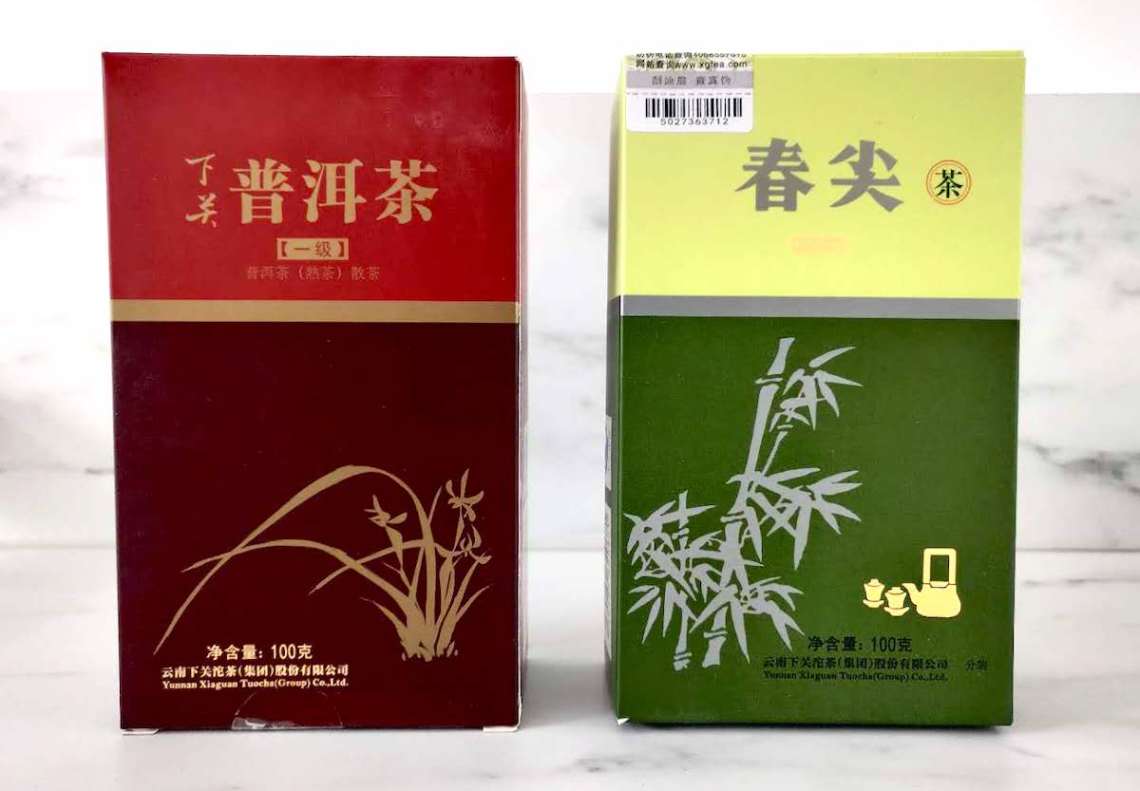For pu erh enthousiasts, Xiaguan is without doubt the brand that is defined by their signature tightly compressed tuocha shape (bowl shape). In 2016, Xiaguan surprised the world by releasing a raw and ripe loose pu erh tea in fancy boxes. Since we got our hands on both of them through Puerhtea.eu, it’s time to taste and review!

As we can see both the ripe (left) and raw (right) packaging are similar in style with a bamboo print in the front. Both packaged state that it contains 100g of tea and that ‘first grade’ (一级) leaves are used. The ripe pu erh box simply states ‘pu erh tea’ as its title, while the raw variant is called ‘Spring Tips’.
2016 Xiaguan Spring Tips Review
When opening the bag inside the, we directly noticed that the tea was very fragrant and sweet, almost like a freshly roasted oolong. A fully sealed bag, must have kept all the aroma perfectly inside.
The leaves of this 2016 Xiaguan Spring Tips look very nicely uniform consisting of small leaves and some stem. The color suggest some decent level of aging as can expected for a 4 year old raw pu erh.

For this tea we’re brewing 4 grams of tea with 120ml of water at 90ºC. We performed a quick rinse, followed by a 10 second steep, which was increased by 5 seconds for every subsequent brew. A 10 second steep is fairly short, but very suitable for loose pu erhs, because they release flavour faster.
The flavour of this tea was quite surprising, because it stands in great contrast to Xiaguan’s raw tuochas that tend to be quite crisp and medicinal in flavour. This loose leaf tea instead, is overwhelming in honey aroma with flowery notes of osmanthus. There’s also hints of peach and sugar cane.
The tea soup has a dark yellow oily look, and the thickness is similar to a light oolong like Tieguanyin. The first 5 steeps very smooth, but we noticed a slight dryness in the after taste in the later steeps. Perhaps, dryness is drown out more while the steeping time is increased. We expect this to be reduced significantly in another 2 years of aging. We managed to get 9 very tasty steeps, which is a very decent yield for 4 grams of tea. Below a picture of the wet leaves.

We would highly recommend this tea to those who are fan of sweet and very aromatic teas. This would also be a great choice for the beginning raw pu erh drinker. The taste is very accessible and the intensity similar to a dark oolong that has undergone a light roast.
2016 Xiaguan Ripe First Grade Loose Pu Erh Review
What the ripe version has in common is that it’s also very subtle processed like the raw one. The dry tea leaves of the 2016 Xiaguan First Grade Ripe loose tea instantly suggested that the post fermentation is rather light relative to some very ‘wet’ ripes.

Like the raw pu erh, we’re steeping 4 grams with 120ml of water. However, we’ll increase the temperature to 95ºC as we’re dealing with a ripe pu erh. Again, a quick rinse and a 10 second steep + 5 sec for every following brew.
The flavour is as you can expect from a lightly fermented ripe pu erh. It’s malty, woody, and it has sweet notes of dates and ripe fruit. There’s some wet wood flavour as expected from a ripe pu erh, but its very balanced and controlled. Later steeps also reveal a slight minty sensation on the tip of your tongue.
Compared to a more strongly fermented ripe, this ripe pu erh is a more moderate body. It’s definitely less thick, but still very smooth. It’s also less earthy, more delicate, and its intensity hangs between that of an average ripe pu erh and a black tea. Here’s a pic of the wet leaves:

Again, we definitely can see Xiaguan’s intention here to target a broader audience. Instead of an aggressive wet piling production process, they went for a more balanced post-fermentation, resulting in a sweet and highly accessible flavour.
Conclusion
Back to the title. We claimed that these teas are not so Xiaguan. Based on the tasting, we’re at least partially right. The loose leaf teas are no where near the taste of a classic tuocha. Instead of satisfying its hardcore audience, Xiaguan’s intention is to create sweeter and more accessible teas for a wider audience. And they absolutely succeeded in this.
Yet, we could still somehow tell this is a Xiaguan product. There’s still a certain Xiaguan flavour that is really unique to just Xiaguan. It’s just hard to describe in words. Curious? You’ve got to try it to find out yourself! Recommend to also get one of Xiaguan’s classic raw and ripe tuochas to compare.
Have you tried Xiaguan’s loose leaf tea offerings before? Share your experiences in the below comment section!
Discover more from Hello Tea Cup
Subscribe to get the latest posts sent to your email.



No Comments